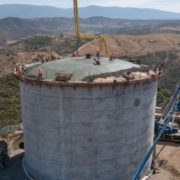Hauck Mesa Storage Reservoir Moving to Completion
The San Diego County Water Authority Hauck Mesa Storage Reservoir project in North San Diego County reached a major milestone in late April when crews poured the concrete roof of the new prestressed concrete water tank. The major construction project, which began in March 2021, will improve drinking water supply reliability for the county.
The project began with the demolition of an abandoned steel tank, and includes construction of an isolation vault and an underground flow control facility, in addition to the new 2.1 million-gallon water tank connected to the Valley Center Pipeline. The project is expected to be completed by November 2022.
Improved flexibility with Hauck Mesa Reservoir
The new Hauck Mesa Storage Reservoir will increase operational flexibility by balancing the flow of treated water between the agency’s first and second aqueducts as well as ensure water deliveries can be maintained even if power supplies are interrupted.
The walls of the new tank are about 60 feet tall, will be stained a forest green color to blend in with the natural landscape, and are made of prestressed, or wire wrapped, concrete. Construction Manager Emma Ward-McNally said that the prestressed technology “will maintain the tank walls in permanent compression, allowing the tank to accommodate seismic events while remaining watertight.”
Next steps for the project include the wire wrapping of the water tank, applying green-tinted shotcrete to the tank walls, installation of mechanical components within the flow control facility, system commissioning, and paving of the project site and access road.
Asset management
Strategic infrastructure improvements by the Water Authority and its 24 member agencies are part of the regional effort to ensure continued delivery of water to support the region’s $240 billion economy and the quality of life for 3.3 million residents. As part of the asset management program, it is critical to actively replace and repair the Water Authority’s assets, which include pipes, valves, facilities, equipment, and other infrastructure.
The Water Authority will continue to work closely with the Valley Center community, Valley Center Municipal Water District, and nearby homeowners to minimize short-term construction impacts.



